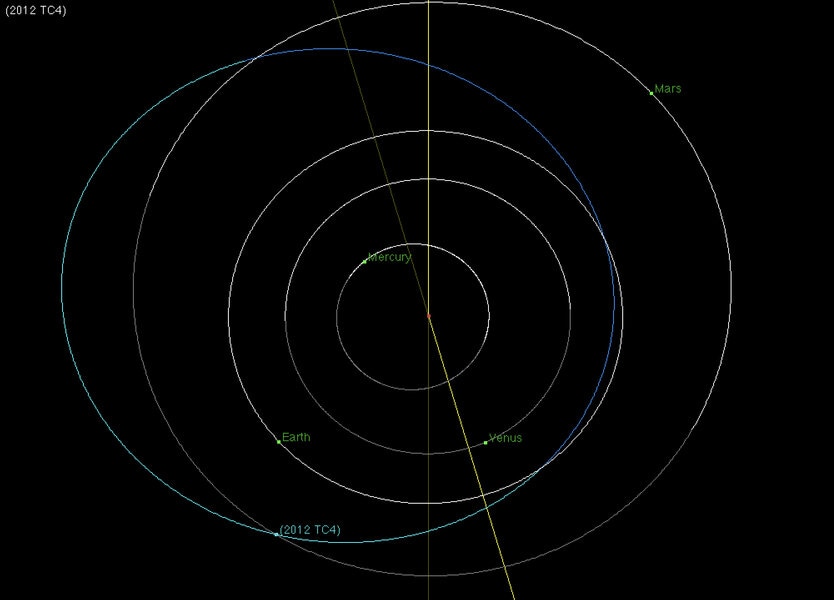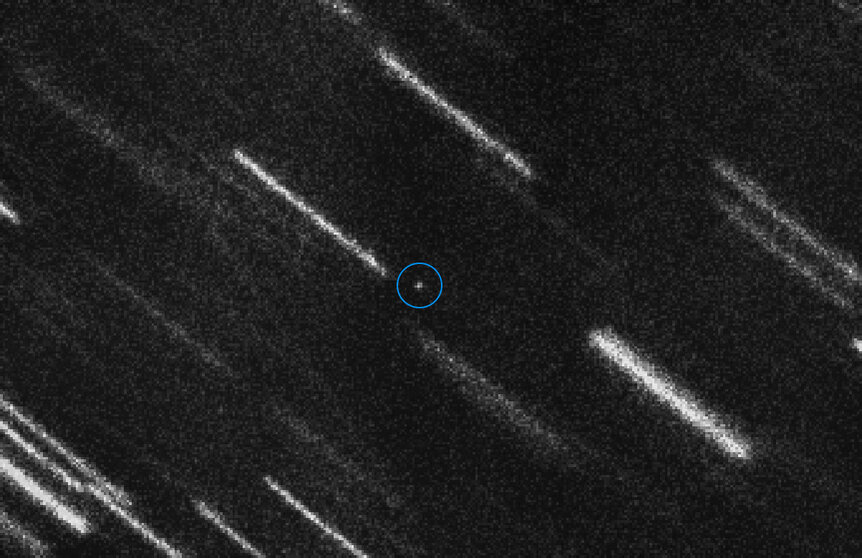Create a free profile to get unlimited access to exclusive videos, sweepstakes, and more!
Two space rocks will (safely!) buzz Earth this fall

In the coming months, two asteroids will make relatively close passes by the Earth. Called 3122 Florence and 2012 TC4, neither will hit us — so don’t panic! —though TC4 will come pretty dang close.
Let’s talk about TC4, first. It was discovered in 2012, and is small, about 20 meters across. It takes just over two years to orbit the Sun, going out as far as the orbit of Mars and back to just inside the Earth’s orbit. It will pass the Earth once again on October 12, 2017.
Until very recently, it wasn’t clear just how close it would get to Earth at that time; the last observations were made back in 2012, and the farther into the future you try to project an asteroid’s orbit, the fuzzier that prediction gets. I’ve likened it to being an outfielder in a baseball game: The longer you can keep your eyes on the ball, the better you’ll know just where it is. If you had to close your eyes a second after the batter hit it, you’d only have a vague idea where the ball would be when it gets near you!
Even though we knew the orbit of TC4 well enough from the previous observations to rule out an impact, the news gets better: It was recovered (that is, seen again since the first set of observations) on July 27, 2017 using the Very Large Telescope in Chile. These new observations improved the orbital calculations a lot, and we now know it’ll most likely pass about 44,000 km above Earth’s surface! A close shave, to be sure, (about three times Earth’s diameter), but a miss, nonetheless.
In fact, this asteroid gets close enough that it makes a great test case for detecting incoming asteroids and determining their orbits. Astronomers from NASA are using TC4’s approach as an exercise to test their systems, initially setting things up to recover it, track it, and characterize the asteroid’s orbit.
It wasn’t expected to be visible again for a few weeks, but the VLT observations threw something of a monkey in the wrench of that. I’m not surprised they were surprised by the early recovery; when VLT saw it, TC4 was incredibly faint. At magnitude 26.8 (!), the faintest star you can see with your naked eye is 200 million times brighter. But VLT has an 8-meter mirror, so it has quite an advantage in detecting ridiculously faint objects.
Still, there’s much that can be done. Astronomers all over the world will track it and, most excitingly, it will be observed using the Goldstone radio antenna, which can ping it with radar and get good measurements of its size, rough shape, and rotation rate. Observations from 2012 clearly showed TC4 changing in brightness as it passed us, which indicates it is elongated and rotating about once every 12 minutes.
It’ll be a challenging target for small telescopes; it’ll be faint (around magnitude 16) until a few hours before closest approach, and, even then, it’ll only brighten to about magnitude 13 (about 600 times fainter than the faintest star you can see naked eye). It’ll also be screaming across the sky, at least as far as asteroids go, moving at several degrees per hour. Hopefully, as more observatories watch it, the orbit will get nailed down, and its position in the sky can be more accurately predicted.
By the way, since I know people will ask: A collision with TC4 would be bad, though not apocalyptic. It’s roughly the same size as the rock that blew up over Chelyabinsk, Russia in 2013. I don’t want to downplay this, nor do I want to exaggerate it: That one exploded with the force of about a half million tons of TNT, which is substantial (like a small nuclear weapon), but localized. It was fortunate that no one was killed in that event (though a thousand were injured by flying glass when the shock wave from the explosion shattered windows), but had circumstances been slightly different, there could have been fatalities. So, an impact like that is a concern.
And, in fact, that’s one of the major reasons astronomers want to study TC4. If another asteroid like it does come in on an impact trajectory some day, then our best weapon is our scientific knowledge of it. Well that, and a rocket with a kinetic impactor on it.
The other rock that will pass us soon is 3122 Florence, which will sail past Earth on September 1, 2017 at a distance of about 7 million kilometers (more than 15 times the distance from the Earth to the Moon). That’s a much larger margin than for TC4, but this encounter is no less interesting. Why? Because Florence is big.
Florence is about 5 kilometers (3 miles) across, and is, in fact, one of the biggest near-Earth asteroids known. Technically, Florence is what we call a “potentially hazardous asteroid,” because not only does its orbit brings it very close to Earth, but it’s also large enough to do serious, global damage should it hit us.
However, to be very clear, at the present time, an impact isn’t possible. That’s because of the way its orbit is tipped as it goes around the Sun: It doesn’t physically cross Earth’s orbit; it just gets close to us. And 7 million kilometers is a long way; even though it’s a big rock, it won’t get bright enough to see without optical aid. It’ll be visible in binoculars from a dark site, but a small telescope is what you’d really need to see it (JPL has software to calculate ephemerides —coordinates on the sky over time— if you have some observational experience and want to see it, yourself).
Having said that, orbits do change over time due to the gravitational influences of the planets and other forces, so it’s possible some time in the distant future it might hit us, but that day won’t be for a long, long time. In fact, this encounter is the closest it will get for at least the next 160 years! There will be several close encounters between now and the year 2177, but all are at least slightly farther away than this one will be.
So, far from being scared about this, you should be excited. This is the closest a large asteroid will safely get to us for some time, so the potential for scientific observations is great. I haven’t heard a lot about what’s planned, just yet, but hopefully we’ll hear something soon, and also get some fun images of it once it passes us by.
Asteroids are scientifically fascinating; rubble that’s suffered countless impacts from other rocks over the billions of years of history of our solar system. By studying them, we learn so much about how our cosmic neighborhood came to be, and how it’s changed since its formation. And while the threat from them at any one time is low, it’s still real. So, studying them is critical.
As is usually the case, science may very well save the world.





























